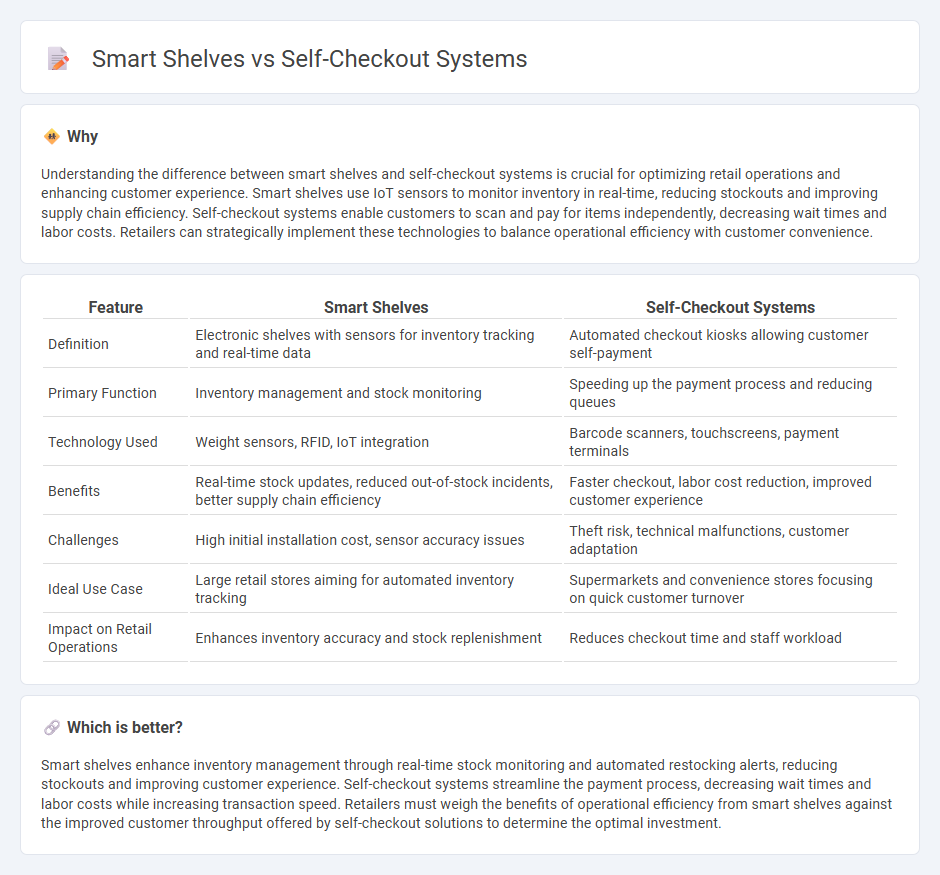
Smart shelves leverage RFID technology and real-time inventory tracking to enhance product availability and reduce stockouts, improving customer experience and operational efficiency. Self-checkout systems enable faster transactions by allowing customers to scan and pay for items independently, reducing labor costs and minimizing checkout lines. Discover how integrating smart shelves and self-checkout systems can transform retail operations and boost sales.
Why it is important
Understanding the difference between smart shelves and self-checkout systems is crucial for optimizing retail operations and enhancing customer experience. Smart shelves use IoT sensors to monitor inventory in real-time, reducing stockouts and improving supply chain efficiency. Self-checkout systems enable customers to scan and pay for items independently, decreasing wait times and labor costs. Retailers can strategically implement these technologies to balance operational efficiency with customer convenience.
Comparison Table
| Feature | Smart Shelves | Self-Checkout Systems |
|---|---|---|
| Definition | Electronic shelves with sensors for inventory tracking and real-time data | Automated checkout kiosks allowing customer self-payment |
| Primary Function | Inventory management and stock monitoring | Speeding up the payment process and reducing queues |
| Technology Used | Weight sensors, RFID, IoT integration | Barcode scanners, touchscreens, payment terminals |
| Benefits | Real-time stock updates, reduced out-of-stock incidents, better supply chain efficiency | Faster checkout, labor cost reduction, improved customer experience |
| Challenges | High initial installation cost, sensor accuracy issues | Theft risk, technical malfunctions, customer adaptation |
| Ideal Use Case | Large retail stores aiming for automated inventory tracking | Supermarkets and convenience stores focusing on quick customer turnover |
| Impact on Retail Operations | Enhances inventory accuracy and stock replenishment | Reduces checkout time and staff workload |
Which is better?
Smart shelves enhance inventory management through real-time stock monitoring and automated restocking alerts, reducing stockouts and improving customer experience. Self-checkout systems streamline the payment process, decreasing wait times and labor costs while increasing transaction speed. Retailers must weigh the benefits of operational efficiency from smart shelves against the improved customer throughput offered by self-checkout solutions to determine the optimal investment.
Connection
Smart shelves equipped with IoT sensors continuously monitor inventory levels and product placement, feeding real-time data into self-checkout systems to streamline the shopping experience. This integration reduces checkout times by automatically updating the system with accurate product information and prices, minimizing errors and the need for manual scanning. Retailers benefit from enhanced operational efficiency and improved customer satisfaction through this seamless connectivity between smart shelves and self-checkout technology.
Key Terms
Automation
Self-checkout systems streamline retail automation by allowing customers to scan, pay, and bag items independently, reducing labor costs and wait times. Smart shelves enhance inventory management through real-time data tracking and automatic stock replenishment, optimizing supply chain efficiency. Explore the latest advancements in retail automation to discover which technology best suits your business needs.
Inventory Management
Self-checkout systems streamline the purchasing process by enabling customers to scan and pay for items independently, reducing cashier labor and checkout time. Smart shelves enhance inventory management by using weight sensors and RFID technology to monitor stock levels in real-time, allowing retailers to automatically update inventory and prevent out-of-stock situations. Explore how integrating both technologies can optimize retail operations and improve inventory accuracy.
Customer Experience
Self-checkout systems enhance customer experience by reducing wait times and providing quick, autonomous payment options, which streamline the in-store journey. Smart shelves improve shopping convenience by offering real-time inventory updates and personalized product recommendations, ensuring customers find what they need efficiently. Explore how these technologies transform retail environments to boost satisfaction and operational efficiency.
Source and External Links
Self-checkouts - Everything you need to know - Snabble - Self-checkout systems allow customers to scan and pay for their items independently using barcode scanners, touchscreens, and payment modules, offering a faster checkout process and reducing staff needs, especially useful during peak times in food, drugstores, and DIY sectors.
Self-checkout - Wikipedia - Self-checkout machines enable customers to complete purchases without staffed assistance by scanning items and paying on their own, widely used in supermarkets and growing rapidly worldwide, with over 1.2 million units expected by 2025.
Making the Case for Better Self-Checkout Systems - NMI - Self-checkout systems boost efficiency by reducing wait times and lowering operating costs by allowing fewer staff to supervise multiple checkouts, providing consumer convenience and accessibility, with a strong market growth trend driven by post-pandemic demand.
 dowidth.com
dowidth.com